ACC73001 Advanced Management Accounting: Toyota Supply Chain Analysis
VerifiedAdded on 2022/09/11
|12
|2502
|13
Report
AI Summary
This report provides a comprehensive analysis of Toyota's supply chain and inventory management systems, focusing on the RAV4 model. The study begins with an introduction to Toyota's commitment to quality and customer value, followed by an analysis of target costing for RAV4 products, including sensitivity analysis to determine optimal production costs at various market prices. The report then examines profit margin recommendations, emphasizing the importance of lowering variable costs through techniques like Just-in-Time (JIT) and JIDOKA. A value chain analysis of Toyota is conducted, highlighting the adoption of Lean thinking, Total Quality Management (TQM), and the Theory of Constraints (TOC). The report explores both market-based and cost-based pricing strategies, recommending final prices for different RAV4 models. Furthermore, the report discusses Toyota's distribution strategy, including indirect distribution channels through merchant wholesalers and retailers, to ensure consistent branding and accessibility for customers. Overall, the report offers insights into Toyota's operational and marketing strategies to achieve higher profitability and efficiency.
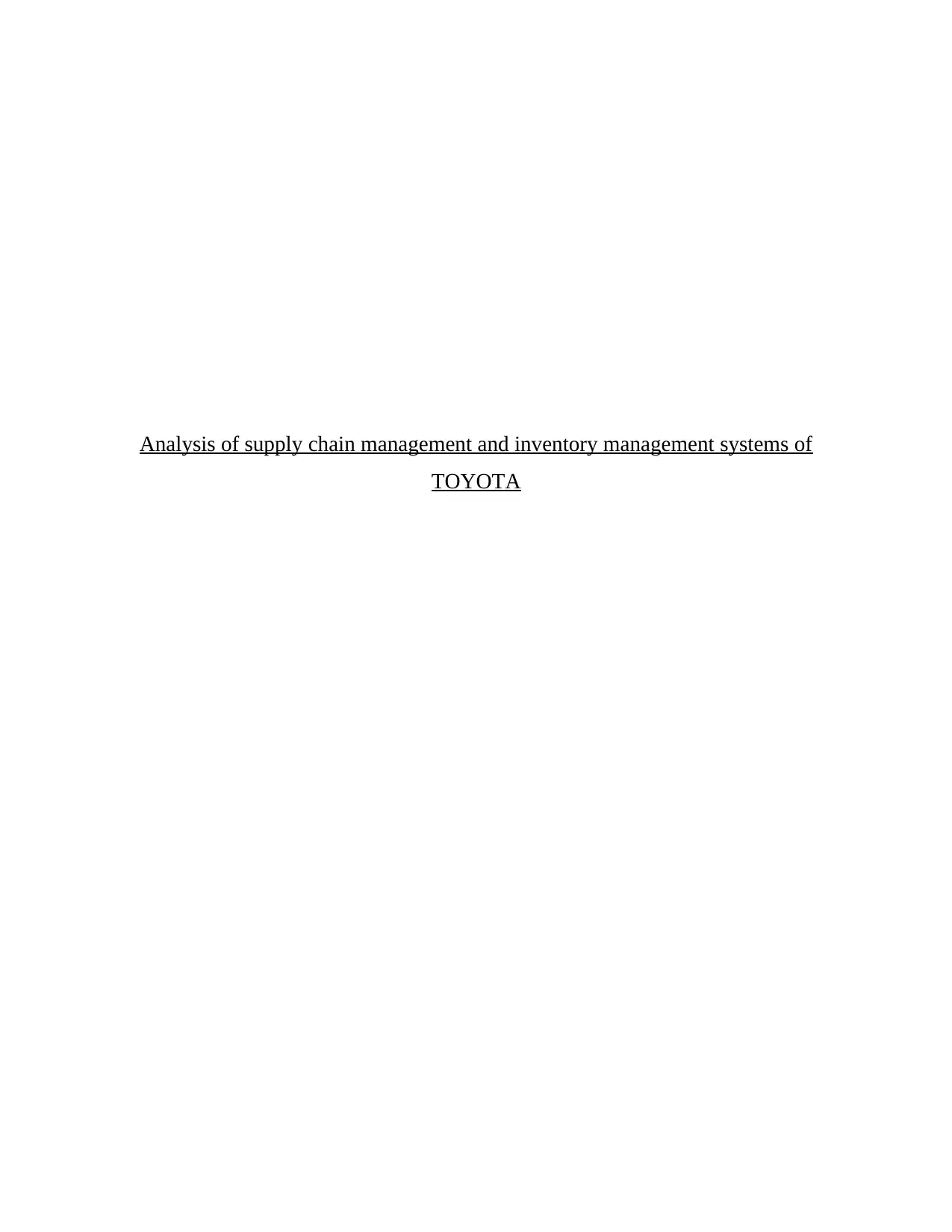
Analysis of supply chain management and inventory management systems of
TOYOTA
TOYOTA
Paraphrase This Document
Need a fresh take? Get an instant paraphrase of this document with our AI Paraphraser
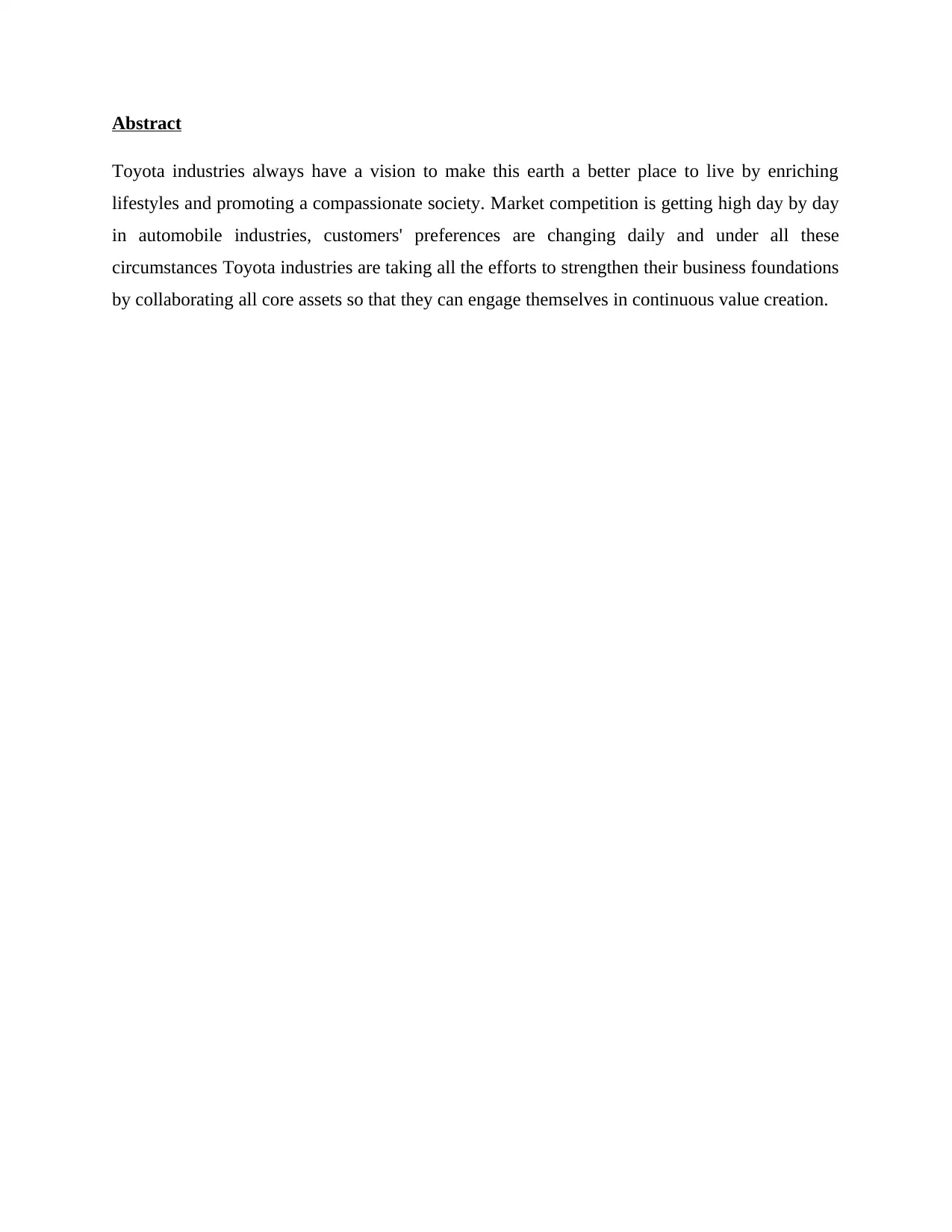
Abstract
Toyota industries always have a vision to make this earth a better place to live by enriching
lifestyles and promoting a compassionate society. Market competition is getting high day by day
in automobile industries, customers' preferences are changing daily and under all these
circumstances Toyota industries are taking all the efforts to strengthen their business foundations
by collaborating all core assets so that they can engage themselves in continuous value creation.
Toyota industries always have a vision to make this earth a better place to live by enriching
lifestyles and promoting a compassionate society. Market competition is getting high day by day
in automobile industries, customers' preferences are changing daily and under all these
circumstances Toyota industries are taking all the efforts to strengthen their business foundations
by collaborating all core assets so that they can engage themselves in continuous value creation.
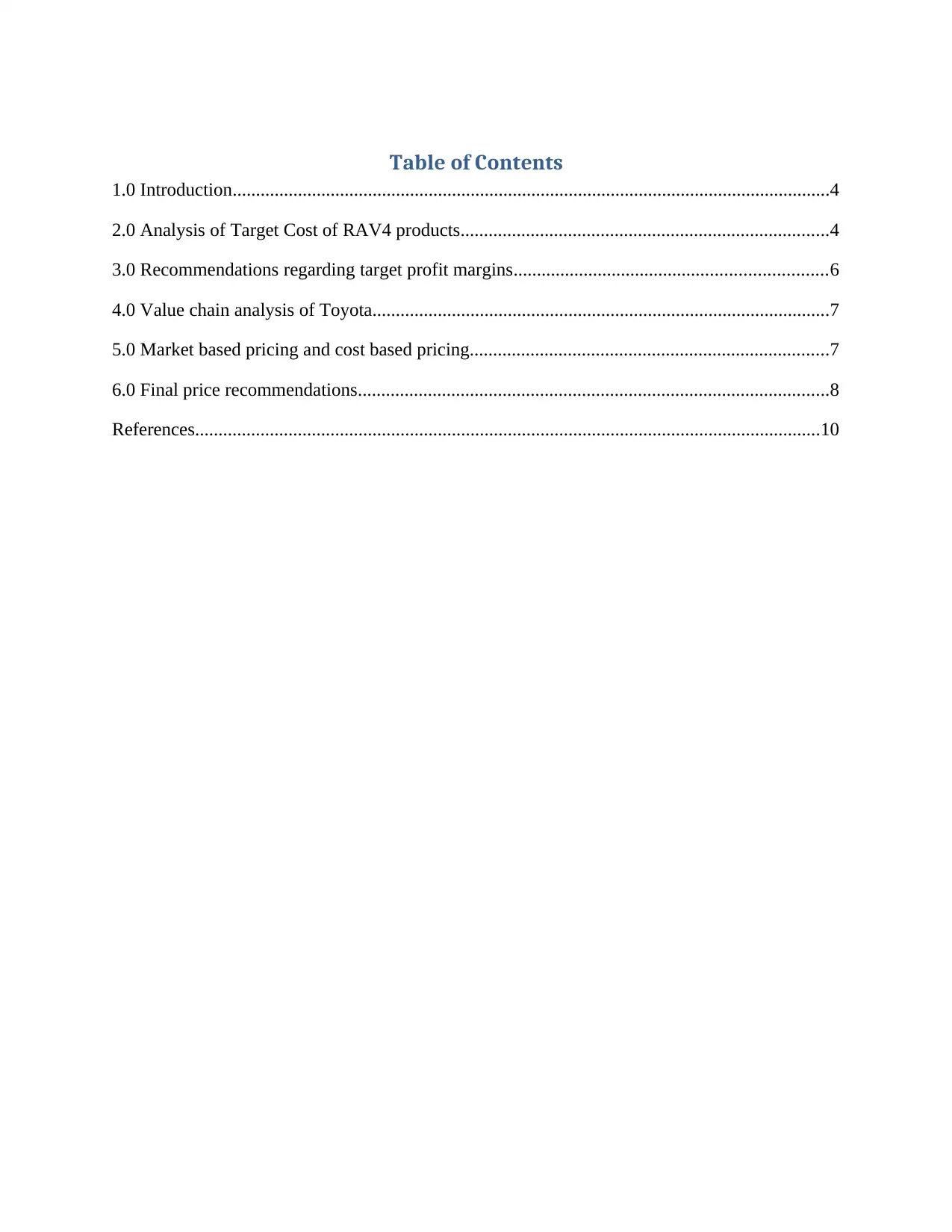
Table of Contents
1.0 Introduction................................................................................................................................4
2.0 Analysis of Target Cost of RAV4 products...............................................................................4
3.0 Recommendations regarding target profit margins...................................................................6
4.0 Value chain analysis of Toyota..................................................................................................7
5.0 Market based pricing and cost based pricing.............................................................................7
6.0 Final price recommendations.....................................................................................................8
References......................................................................................................................................10
1.0 Introduction................................................................................................................................4
2.0 Analysis of Target Cost of RAV4 products...............................................................................4
3.0 Recommendations regarding target profit margins...................................................................6
4.0 Value chain analysis of Toyota..................................................................................................7
5.0 Market based pricing and cost based pricing.............................................................................7
6.0 Final price recommendations.....................................................................................................8
References......................................................................................................................................10
⊘ This is a preview!⊘
Do you want full access?
Subscribe today to unlock all pages.

Trusted by 1+ million students worldwide
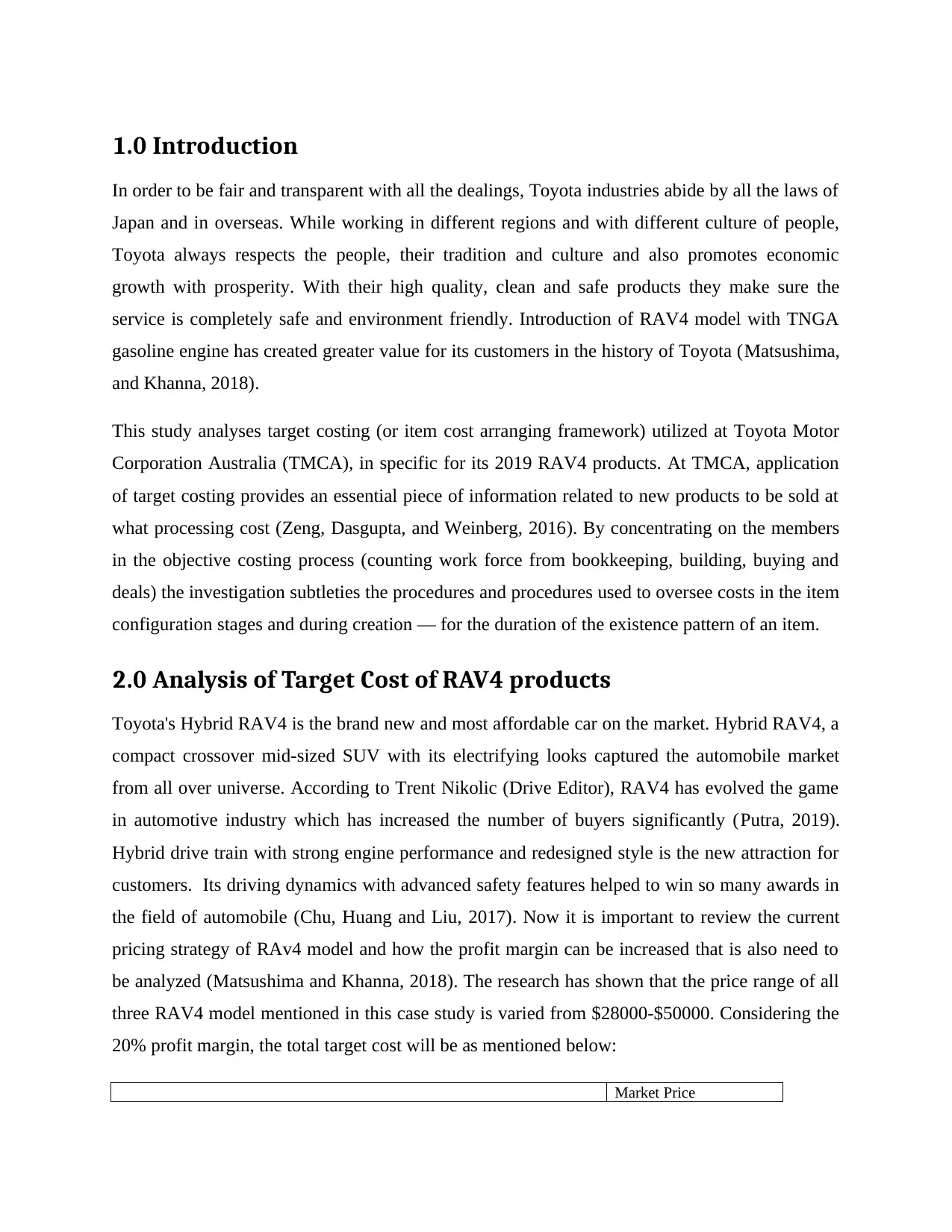
1.0 Introduction
In order to be fair and transparent with all the dealings, Toyota industries abide by all the laws of
Japan and in overseas. While working in different regions and with different culture of people,
Toyota always respects the people, their tradition and culture and also promotes economic
growth with prosperity. With their high quality, clean and safe products they make sure the
service is completely safe and environment friendly. Introduction of RAV4 model with TNGA
gasoline engine has created greater value for its customers in the history of Toyota (Matsushima,
and Khanna, 2018).
This study analyses target costing (or item cost arranging framework) utilized at Toyota Motor
Corporation Australia (TMCA), in specific for its 2019 RAV4 products. At TMCA, application
of target costing provides an essential piece of information related to new products to be sold at
what processing cost (Zeng, Dasgupta, and Weinberg, 2016). By concentrating on the members
in the objective costing process (counting work force from bookkeeping, building, buying and
deals) the investigation subtleties the procedures and procedures used to oversee costs in the item
configuration stages and during creation — for the duration of the existence pattern of an item.
2.0 Analysis of Target Cost of RAV4 products
Toyota's Hybrid RAV4 is the brand new and most affordable car on the market. Hybrid RAV4, a
compact crossover mid-sized SUV with its electrifying looks captured the automobile market
from all over universe. According to Trent Nikolic (Drive Editor), RAV4 has evolved the game
in automotive industry which has increased the number of buyers significantly (Putra, 2019).
Hybrid drive train with strong engine performance and redesigned style is the new attraction for
customers. Its driving dynamics with advanced safety features helped to win so many awards in
the field of automobile (Chu, Huang and Liu, 2017). Now it is important to review the current
pricing strategy of RAv4 model and how the profit margin can be increased that is also need to
be analyzed (Matsushima and Khanna, 2018). The research has shown that the price range of all
three RAV4 model mentioned in this case study is varied from $28000-$50000. Considering the
20% profit margin, the total target cost will be as mentioned below:
Market Price
In order to be fair and transparent with all the dealings, Toyota industries abide by all the laws of
Japan and in overseas. While working in different regions and with different culture of people,
Toyota always respects the people, their tradition and culture and also promotes economic
growth with prosperity. With their high quality, clean and safe products they make sure the
service is completely safe and environment friendly. Introduction of RAV4 model with TNGA
gasoline engine has created greater value for its customers in the history of Toyota (Matsushima,
and Khanna, 2018).
This study analyses target costing (or item cost arranging framework) utilized at Toyota Motor
Corporation Australia (TMCA), in specific for its 2019 RAV4 products. At TMCA, application
of target costing provides an essential piece of information related to new products to be sold at
what processing cost (Zeng, Dasgupta, and Weinberg, 2016). By concentrating on the members
in the objective costing process (counting work force from bookkeeping, building, buying and
deals) the investigation subtleties the procedures and procedures used to oversee costs in the item
configuration stages and during creation — for the duration of the existence pattern of an item.
2.0 Analysis of Target Cost of RAV4 products
Toyota's Hybrid RAV4 is the brand new and most affordable car on the market. Hybrid RAV4, a
compact crossover mid-sized SUV with its electrifying looks captured the automobile market
from all over universe. According to Trent Nikolic (Drive Editor), RAV4 has evolved the game
in automotive industry which has increased the number of buyers significantly (Putra, 2019).
Hybrid drive train with strong engine performance and redesigned style is the new attraction for
customers. Its driving dynamics with advanced safety features helped to win so many awards in
the field of automobile (Chu, Huang and Liu, 2017). Now it is important to review the current
pricing strategy of RAv4 model and how the profit margin can be increased that is also need to
be analyzed (Matsushima and Khanna, 2018). The research has shown that the price range of all
three RAV4 model mentioned in this case study is varied from $28000-$50000. Considering the
20% profit margin, the total target cost will be as mentioned below:
Market Price
Paraphrase This Document
Need a fresh take? Get an instant paraphrase of this document with our AI Paraphraser
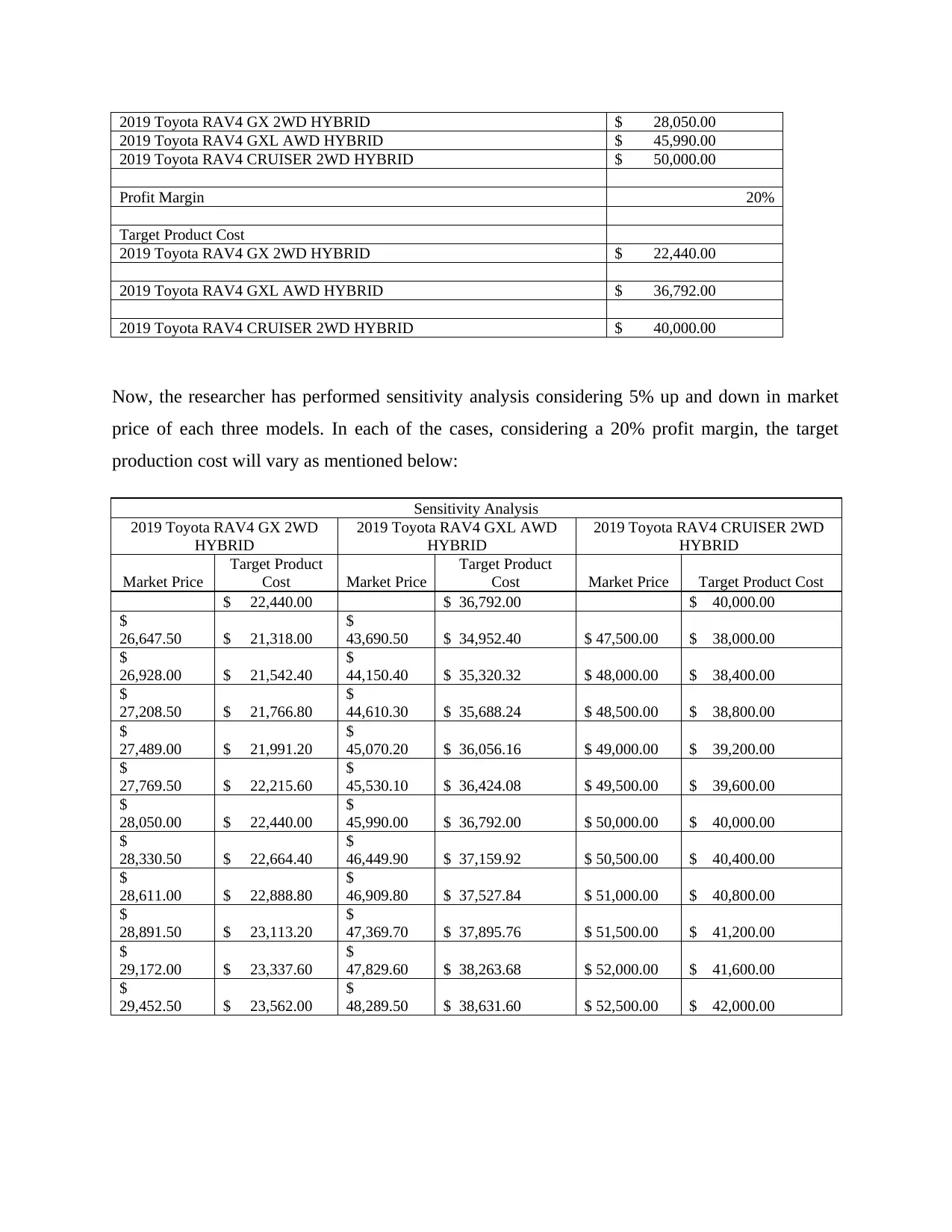
2019 Toyota RAV4 GX 2WD HYBRID $ 28,050.00
2019 Toyota RAV4 GXL AWD HYBRID $ 45,990.00
2019 Toyota RAV4 CRUISER 2WD HYBRID $ 50,000.00
Profit Margin 20%
Target Product Cost
2019 Toyota RAV4 GX 2WD HYBRID $ 22,440.00
2019 Toyota RAV4 GXL AWD HYBRID $ 36,792.00
2019 Toyota RAV4 CRUISER 2WD HYBRID $ 40,000.00
Now, the researcher has performed sensitivity analysis considering 5% up and down in market
price of each three models. In each of the cases, considering a 20% profit margin, the target
production cost will vary as mentioned below:
Sensitivity Analysis
2019 Toyota RAV4 GX 2WD
HYBRID
2019 Toyota RAV4 GXL AWD
HYBRID
2019 Toyota RAV4 CRUISER 2WD
HYBRID
Market Price
Target Product
Cost Market Price
Target Product
Cost Market Price Target Product Cost
$ 22,440.00 $ 36,792.00 $ 40,000.00
$
26,647.50 $ 21,318.00
$
43,690.50 $ 34,952.40 $ 47,500.00 $ 38,000.00
$
26,928.00 $ 21,542.40
$
44,150.40 $ 35,320.32 $ 48,000.00 $ 38,400.00
$
27,208.50 $ 21,766.80
$
44,610.30 $ 35,688.24 $ 48,500.00 $ 38,800.00
$
27,489.00 $ 21,991.20
$
45,070.20 $ 36,056.16 $ 49,000.00 $ 39,200.00
$
27,769.50 $ 22,215.60
$
45,530.10 $ 36,424.08 $ 49,500.00 $ 39,600.00
$
28,050.00 $ 22,440.00
$
45,990.00 $ 36,792.00 $ 50,000.00 $ 40,000.00
$
28,330.50 $ 22,664.40
$
46,449.90 $ 37,159.92 $ 50,500.00 $ 40,400.00
$
28,611.00 $ 22,888.80
$
46,909.80 $ 37,527.84 $ 51,000.00 $ 40,800.00
$
28,891.50 $ 23,113.20
$
47,369.70 $ 37,895.76 $ 51,500.00 $ 41,200.00
$
29,172.00 $ 23,337.60
$
47,829.60 $ 38,263.68 $ 52,000.00 $ 41,600.00
$
29,452.50 $ 23,562.00
$
48,289.50 $ 38,631.60 $ 52,500.00 $ 42,000.00
2019 Toyota RAV4 GXL AWD HYBRID $ 45,990.00
2019 Toyota RAV4 CRUISER 2WD HYBRID $ 50,000.00
Profit Margin 20%
Target Product Cost
2019 Toyota RAV4 GX 2WD HYBRID $ 22,440.00
2019 Toyota RAV4 GXL AWD HYBRID $ 36,792.00
2019 Toyota RAV4 CRUISER 2WD HYBRID $ 40,000.00
Now, the researcher has performed sensitivity analysis considering 5% up and down in market
price of each three models. In each of the cases, considering a 20% profit margin, the target
production cost will vary as mentioned below:
Sensitivity Analysis
2019 Toyota RAV4 GX 2WD
HYBRID
2019 Toyota RAV4 GXL AWD
HYBRID
2019 Toyota RAV4 CRUISER 2WD
HYBRID
Market Price
Target Product
Cost Market Price
Target Product
Cost Market Price Target Product Cost
$ 22,440.00 $ 36,792.00 $ 40,000.00
$
26,647.50 $ 21,318.00
$
43,690.50 $ 34,952.40 $ 47,500.00 $ 38,000.00
$
26,928.00 $ 21,542.40
$
44,150.40 $ 35,320.32 $ 48,000.00 $ 38,400.00
$
27,208.50 $ 21,766.80
$
44,610.30 $ 35,688.24 $ 48,500.00 $ 38,800.00
$
27,489.00 $ 21,991.20
$
45,070.20 $ 36,056.16 $ 49,000.00 $ 39,200.00
$
27,769.50 $ 22,215.60
$
45,530.10 $ 36,424.08 $ 49,500.00 $ 39,600.00
$
28,050.00 $ 22,440.00
$
45,990.00 $ 36,792.00 $ 50,000.00 $ 40,000.00
$
28,330.50 $ 22,664.40
$
46,449.90 $ 37,159.92 $ 50,500.00 $ 40,400.00
$
28,611.00 $ 22,888.80
$
46,909.80 $ 37,527.84 $ 51,000.00 $ 40,800.00
$
28,891.50 $ 23,113.20
$
47,369.70 $ 37,895.76 $ 51,500.00 $ 41,200.00
$
29,172.00 $ 23,337.60
$
47,829.60 $ 38,263.68 $ 52,000.00 $ 41,600.00
$
29,452.50 $ 23,562.00
$
48,289.50 $ 38,631.60 $ 52,500.00 $ 42,000.00
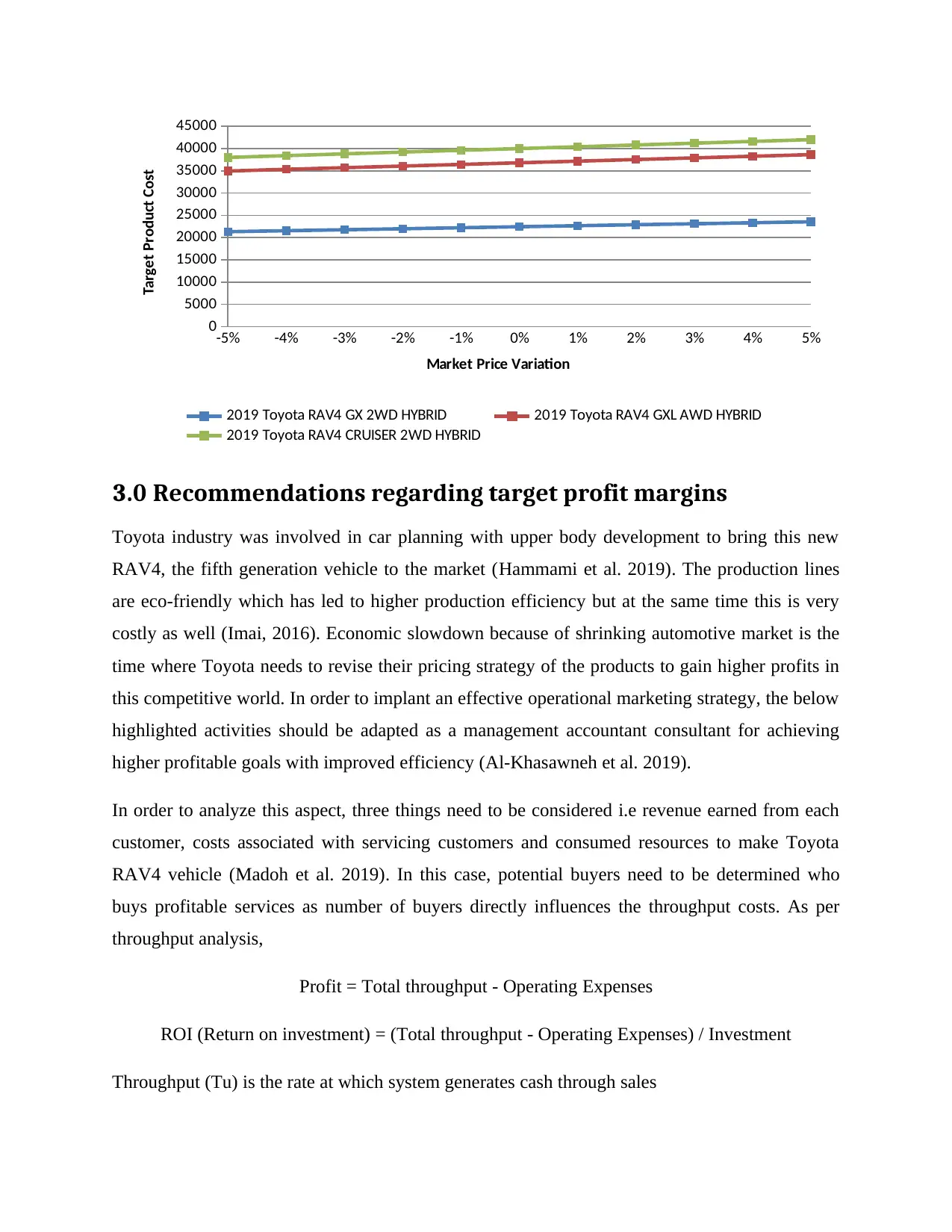
-5% -4% -3% -2% -1% 0% 1% 2% 3% 4% 5%
0
5000
10000
15000
20000
25000
30000
35000
40000
45000
2019 Toyota RAV4 GX 2WD HYBRID 2019 Toyota RAV4 GXL AWD HYBRID
2019 Toyota RAV4 CRUISER 2WD HYBRID
Market Price Variation
Target Product Cost
3.0 Recommendations regarding target profit margins
Toyota industry was involved in car planning with upper body development to bring this new
RAV4, the fifth generation vehicle to the market (Hammami et al. 2019). The production lines
are eco-friendly which has led to higher production efficiency but at the same time this is very
costly as well (Imai, 2016). Economic slowdown because of shrinking automotive market is the
time where Toyota needs to revise their pricing strategy of the products to gain higher profits in
this competitive world. In order to implant an effective operational marketing strategy, the below
highlighted activities should be adapted as a management accountant consultant for achieving
higher profitable goals with improved efficiency (Al-Khasawneh et al. 2019).
In order to analyze this aspect, three things need to be considered i.e revenue earned from each
customer, costs associated with servicing customers and consumed resources to make Toyota
RAV4 vehicle (Madoh et al. 2019). In this case, potential buyers need to be determined who
buys profitable services as number of buyers directly influences the throughput costs. As per
throughput analysis,
Profit = Total throughput - Operating Expenses
ROI (Return on investment) = (Total throughput - Operating Expenses) / Investment
Throughput (Tu) is the rate at which system generates cash through sales
0
5000
10000
15000
20000
25000
30000
35000
40000
45000
2019 Toyota RAV4 GX 2WD HYBRID 2019 Toyota RAV4 GXL AWD HYBRID
2019 Toyota RAV4 CRUISER 2WD HYBRID
Market Price Variation
Target Product Cost
3.0 Recommendations regarding target profit margins
Toyota industry was involved in car planning with upper body development to bring this new
RAV4, the fifth generation vehicle to the market (Hammami et al. 2019). The production lines
are eco-friendly which has led to higher production efficiency but at the same time this is very
costly as well (Imai, 2016). Economic slowdown because of shrinking automotive market is the
time where Toyota needs to revise their pricing strategy of the products to gain higher profits in
this competitive world. In order to implant an effective operational marketing strategy, the below
highlighted activities should be adapted as a management accountant consultant for achieving
higher profitable goals with improved efficiency (Al-Khasawneh et al. 2019).
In order to analyze this aspect, three things need to be considered i.e revenue earned from each
customer, costs associated with servicing customers and consumed resources to make Toyota
RAV4 vehicle (Madoh et al. 2019). In this case, potential buyers need to be determined who
buys profitable services as number of buyers directly influences the throughput costs. As per
throughput analysis,
Profit = Total throughput - Operating Expenses
ROI (Return on investment) = (Total throughput - Operating Expenses) / Investment
Throughput (Tu) is the rate at which system generates cash through sales
⊘ This is a preview!⊘
Do you want full access?
Subscribe today to unlock all pages.

Trusted by 1+ million students worldwide
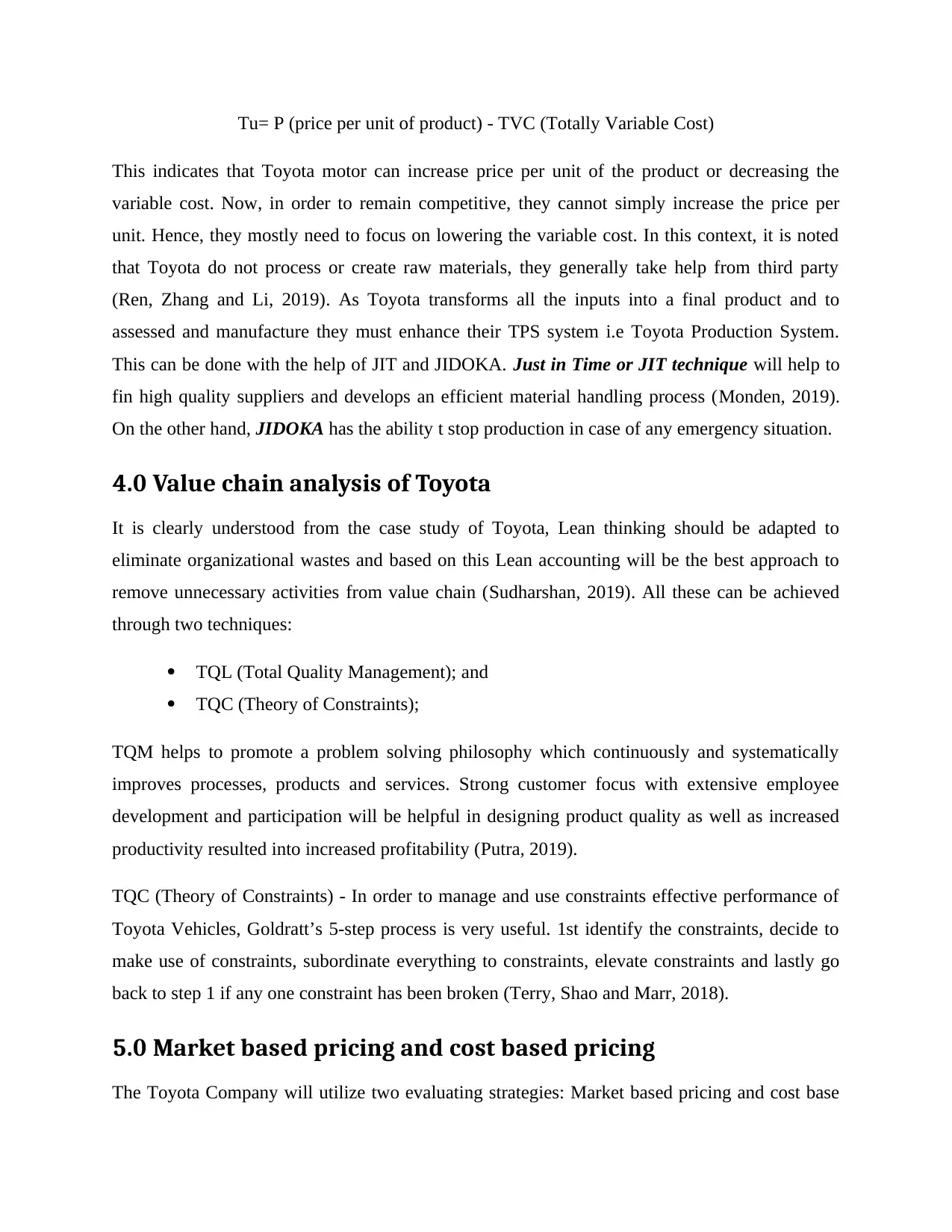
Tu= P (price per unit of product) - TVC (Totally Variable Cost)
This indicates that Toyota motor can increase price per unit of the product or decreasing the
variable cost. Now, in order to remain competitive, they cannot simply increase the price per
unit. Hence, they mostly need to focus on lowering the variable cost. In this context, it is noted
that Toyota do not process or create raw materials, they generally take help from third party
(Ren, Zhang and Li, 2019). As Toyota transforms all the inputs into a final product and to
assessed and manufacture they must enhance their TPS system i.e Toyota Production System.
This can be done with the help of JIT and JIDOKA. Just in Time or JIT technique will help to
fin high quality suppliers and develops an efficient material handling process (Monden, 2019).
On the other hand, JIDOKA has the ability t stop production in case of any emergency situation.
4.0 Value chain analysis of Toyota
It is clearly understood from the case study of Toyota, Lean thinking should be adapted to
eliminate organizational wastes and based on this Lean accounting will be the best approach to
remove unnecessary activities from value chain (Sudharshan, 2019). All these can be achieved
through two techniques:
TQL (Total Quality Management); and
TQC (Theory of Constraints);
TQM helps to promote a problem solving philosophy which continuously and systematically
improves processes, products and services. Strong customer focus with extensive employee
development and participation will be helpful in designing product quality as well as increased
productivity resulted into increased profitability (Putra, 2019).
TQC (Theory of Constraints) - In order to manage and use constraints effective performance of
Toyota Vehicles, Goldratt’s 5-step process is very useful. 1st identify the constraints, decide to
make use of constraints, subordinate everything to constraints, elevate constraints and lastly go
back to step 1 if any one constraint has been broken (Terry, Shao and Marr, 2018).
5.0 Market based pricing and cost based pricing
The Toyota Company will utilize two evaluating strategies: Market based pricing and cost base
This indicates that Toyota motor can increase price per unit of the product or decreasing the
variable cost. Now, in order to remain competitive, they cannot simply increase the price per
unit. Hence, they mostly need to focus on lowering the variable cost. In this context, it is noted
that Toyota do not process or create raw materials, they generally take help from third party
(Ren, Zhang and Li, 2019). As Toyota transforms all the inputs into a final product and to
assessed and manufacture they must enhance their TPS system i.e Toyota Production System.
This can be done with the help of JIT and JIDOKA. Just in Time or JIT technique will help to
fin high quality suppliers and develops an efficient material handling process (Monden, 2019).
On the other hand, JIDOKA has the ability t stop production in case of any emergency situation.
4.0 Value chain analysis of Toyota
It is clearly understood from the case study of Toyota, Lean thinking should be adapted to
eliminate organizational wastes and based on this Lean accounting will be the best approach to
remove unnecessary activities from value chain (Sudharshan, 2019). All these can be achieved
through two techniques:
TQL (Total Quality Management); and
TQC (Theory of Constraints);
TQM helps to promote a problem solving philosophy which continuously and systematically
improves processes, products and services. Strong customer focus with extensive employee
development and participation will be helpful in designing product quality as well as increased
productivity resulted into increased profitability (Putra, 2019).
TQC (Theory of Constraints) - In order to manage and use constraints effective performance of
Toyota Vehicles, Goldratt’s 5-step process is very useful. 1st identify the constraints, decide to
make use of constraints, subordinate everything to constraints, elevate constraints and lastly go
back to step 1 if any one constraint has been broken (Terry, Shao and Marr, 2018).
5.0 Market based pricing and cost based pricing
The Toyota Company will utilize two evaluating strategies: Market based pricing and cost base
Paraphrase This Document
Need a fresh take? Get an instant paraphrase of this document with our AI Paraphraser
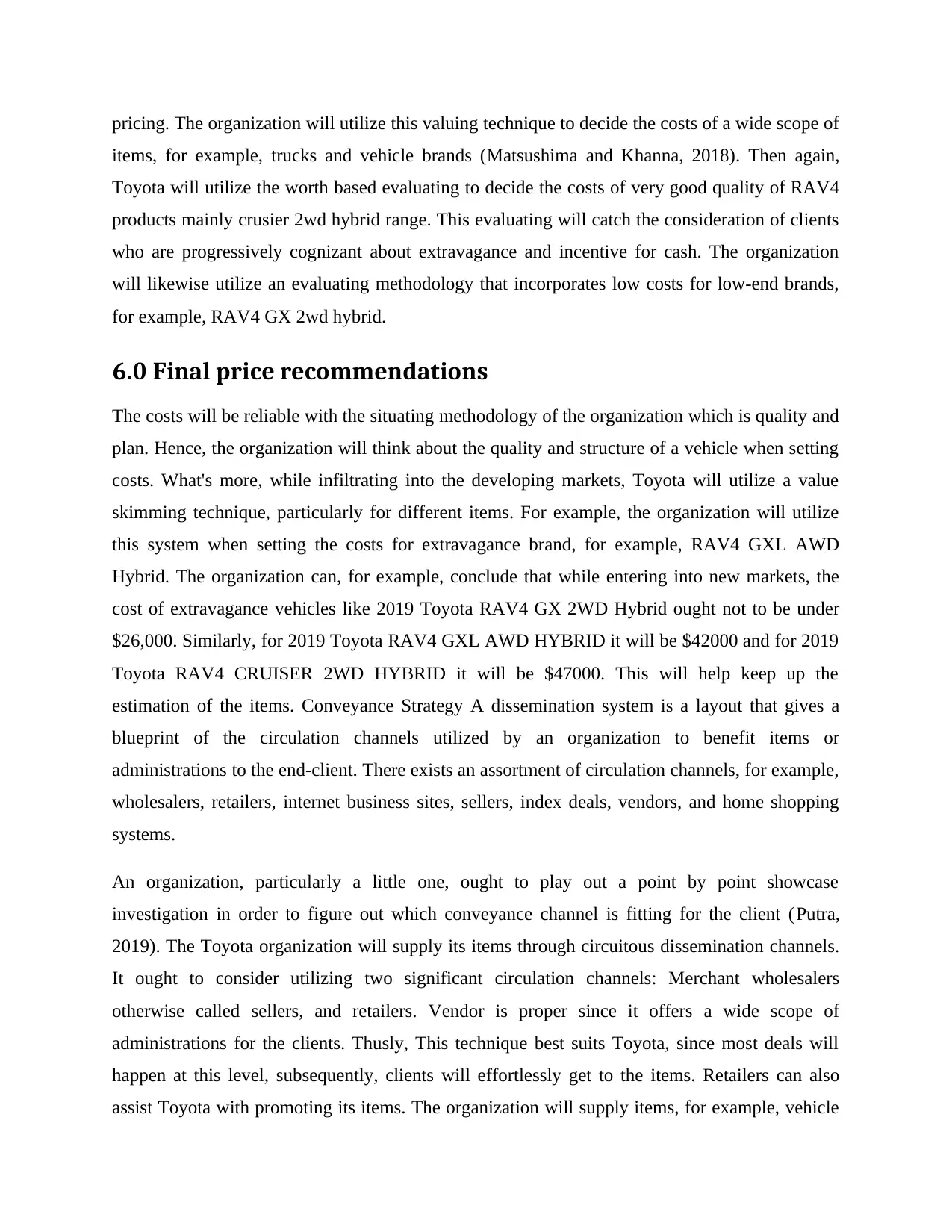
pricing. The organization will utilize this valuing technique to decide the costs of a wide scope of
items, for example, trucks and vehicle brands (Matsushima and Khanna, 2018). Then again,
Toyota will utilize the worth based evaluating to decide the costs of very good quality of RAV4
products mainly crusier 2wd hybrid range. This evaluating will catch the consideration of clients
who are progressively cognizant about extravagance and incentive for cash. The organization
will likewise utilize an evaluating methodology that incorporates low costs for low-end brands,
for example, RAV4 GX 2wd hybrid.
6.0 Final price recommendations
The costs will be reliable with the situating methodology of the organization which is quality and
plan. Hence, the organization will think about the quality and structure of a vehicle when setting
costs. What's more, while infiltrating into the developing markets, Toyota will utilize a value
skimming technique, particularly for different items. For example, the organization will utilize
this system when setting the costs for extravagance brand, for example, RAV4 GXL AWD
Hybrid. The organization can, for example, conclude that while entering into new markets, the
cost of extravagance vehicles like 2019 Toyota RAV4 GX 2WD Hybrid ought not to be under
$26,000. Similarly, for 2019 Toyota RAV4 GXL AWD HYBRID it will be $42000 and for 2019
Toyota RAV4 CRUISER 2WD HYBRID it will be $47000. This will help keep up the
estimation of the items. Conveyance Strategy A dissemination system is a layout that gives a
blueprint of the circulation channels utilized by an organization to benefit items or
administrations to the end-client. There exists an assortment of circulation channels, for example,
wholesalers, retailers, internet business sites, sellers, index deals, vendors, and home shopping
systems.
An organization, particularly a little one, ought to play out a point by point showcase
investigation in order to figure out which conveyance channel is fitting for the client (Putra,
2019). The Toyota organization will supply its items through circuitous dissemination channels.
It ought to consider utilizing two significant circulation channels: Merchant wholesalers
otherwise called sellers, and retailers. Vendor is proper since it offers a wide scope of
administrations for the clients. Thusly, This technique best suits Toyota, since most deals will
happen at this level, subsequently, clients will effortlessly get to the items. Retailers can also
assist Toyota with promoting its items. The organization will supply items, for example, vehicle
items, for example, trucks and vehicle brands (Matsushima and Khanna, 2018). Then again,
Toyota will utilize the worth based evaluating to decide the costs of very good quality of RAV4
products mainly crusier 2wd hybrid range. This evaluating will catch the consideration of clients
who are progressively cognizant about extravagance and incentive for cash. The organization
will likewise utilize an evaluating methodology that incorporates low costs for low-end brands,
for example, RAV4 GX 2wd hybrid.
6.0 Final price recommendations
The costs will be reliable with the situating methodology of the organization which is quality and
plan. Hence, the organization will think about the quality and structure of a vehicle when setting
costs. What's more, while infiltrating into the developing markets, Toyota will utilize a value
skimming technique, particularly for different items. For example, the organization will utilize
this system when setting the costs for extravagance brand, for example, RAV4 GXL AWD
Hybrid. The organization can, for example, conclude that while entering into new markets, the
cost of extravagance vehicles like 2019 Toyota RAV4 GX 2WD Hybrid ought not to be under
$26,000. Similarly, for 2019 Toyota RAV4 GXL AWD HYBRID it will be $42000 and for 2019
Toyota RAV4 CRUISER 2WD HYBRID it will be $47000. This will help keep up the
estimation of the items. Conveyance Strategy A dissemination system is a layout that gives a
blueprint of the circulation channels utilized by an organization to benefit items or
administrations to the end-client. There exists an assortment of circulation channels, for example,
wholesalers, retailers, internet business sites, sellers, index deals, vendors, and home shopping
systems.
An organization, particularly a little one, ought to play out a point by point showcase
investigation in order to figure out which conveyance channel is fitting for the client (Putra,
2019). The Toyota organization will supply its items through circuitous dissemination channels.
It ought to consider utilizing two significant circulation channels: Merchant wholesalers
otherwise called sellers, and retailers. Vendor is proper since it offers a wide scope of
administrations for the clients. Thusly, This technique best suits Toyota, since most deals will
happen at this level, subsequently, clients will effortlessly get to the items. Retailers can also
assist Toyota with promoting its items. The organization will supply items, for example, vehicle
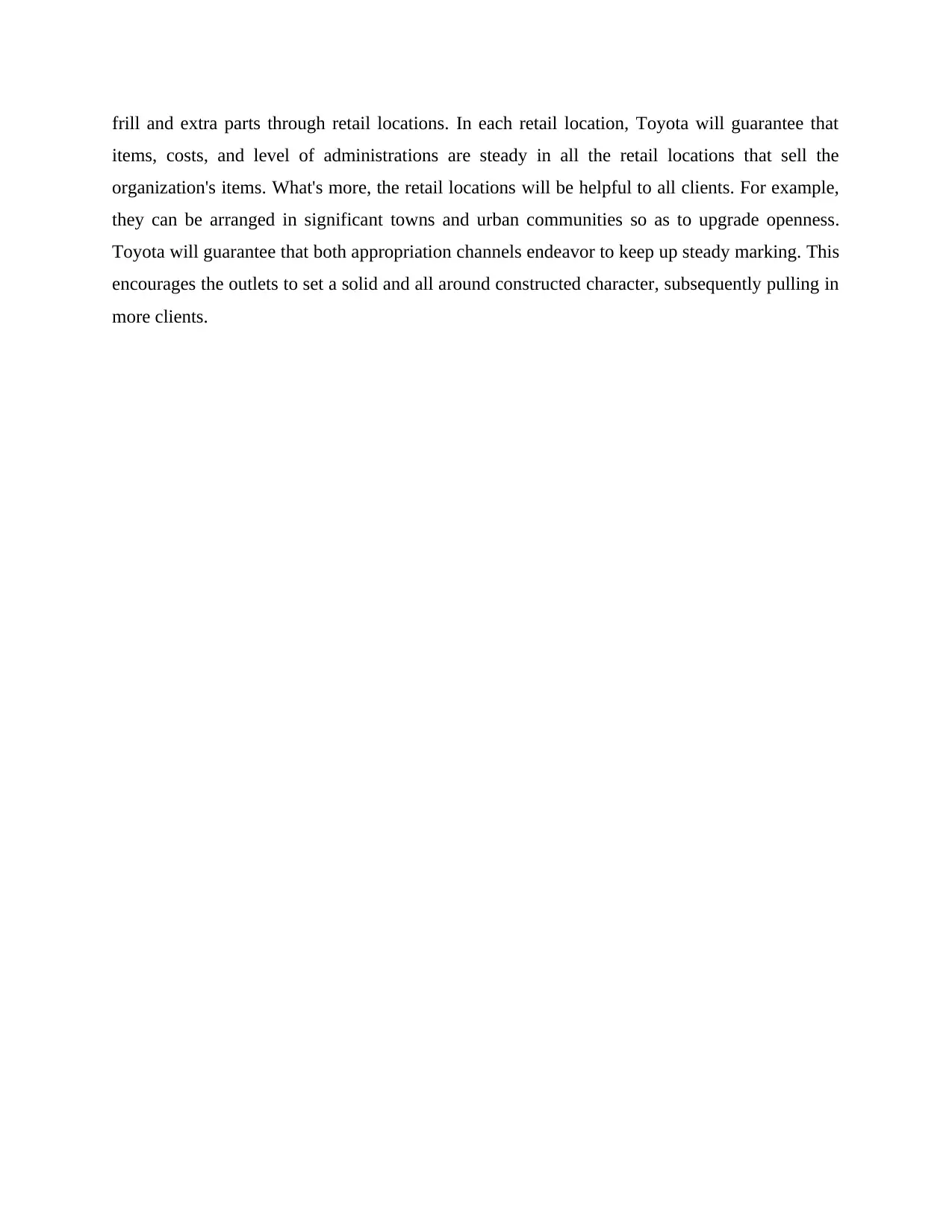
frill and extra parts through retail locations. In each retail location, Toyota will guarantee that
items, costs, and level of administrations are steady in all the retail locations that sell the
organization's items. What's more, the retail locations will be helpful to all clients. For example,
they can be arranged in significant towns and urban communities so as to upgrade openness.
Toyota will guarantee that both appropriation channels endeavor to keep up steady marking. This
encourages the outlets to set a solid and all around constructed character, subsequently pulling in
more clients.
items, costs, and level of administrations are steady in all the retail locations that sell the
organization's items. What's more, the retail locations will be helpful to all clients. For example,
they can be arranged in significant towns and urban communities so as to upgrade openness.
Toyota will guarantee that both appropriation channels endeavor to keep up steady marking. This
encourages the outlets to set a solid and all around constructed character, subsequently pulling in
more clients.
⊘ This is a preview!⊘
Do you want full access?
Subscribe today to unlock all pages.

Trusted by 1+ million students worldwide
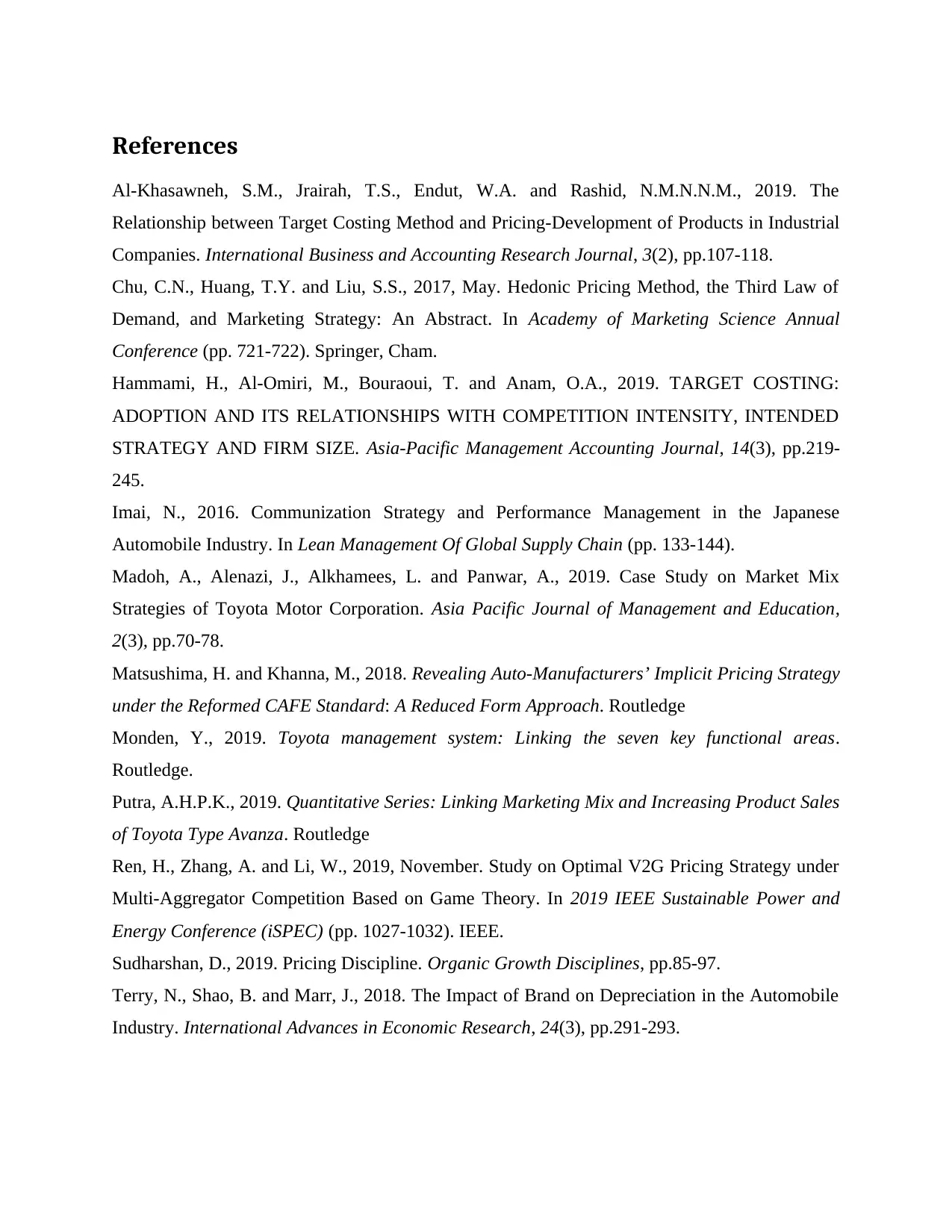
References
Al-Khasawneh, S.M., Jrairah, T.S., Endut, W.A. and Rashid, N.M.N.N.M., 2019. The
Relationship between Target Costing Method and Pricing-Development of Products in Industrial
Companies. International Business and Accounting Research Journal, 3(2), pp.107-118.
Chu, C.N., Huang, T.Y. and Liu, S.S., 2017, May. Hedonic Pricing Method, the Third Law of
Demand, and Marketing Strategy: An Abstract. In Academy of Marketing Science Annual
Conference (pp. 721-722). Springer, Cham.
Hammami, H., Al-Omiri, M., Bouraoui, T. and Anam, O.A., 2019. TARGET COSTING:
ADOPTION AND ITS RELATIONSHIPS WITH COMPETITION INTENSITY, INTENDED
STRATEGY AND FIRM SIZE. Asia-Pacific Management Accounting Journal, 14(3), pp.219-
245.
Imai, N., 2016. Communization Strategy and Performance Management in the Japanese
Automobile Industry. In Lean Management Of Global Supply Chain (pp. 133-144).
Madoh, A., Alenazi, J., Alkhamees, L. and Panwar, A., 2019. Case Study on Market Mix
Strategies of Toyota Motor Corporation. Asia Pacific Journal of Management and Education,
2(3), pp.70-78.
Matsushima, H. and Khanna, M., 2018. Revealing Auto-Manufacturers’ Implicit Pricing Strategy
under the Reformed CAFE Standard: A Reduced Form Approach. Routledge
Monden, Y., 2019. Toyota management system: Linking the seven key functional areas.
Routledge.
Putra, A.H.P.K., 2019. Quantitative Series: Linking Marketing Mix and Increasing Product Sales
of Toyota Type Avanza. Routledge
Ren, H., Zhang, A. and Li, W., 2019, November. Study on Optimal V2G Pricing Strategy under
Multi-Aggregator Competition Based on Game Theory. In 2019 IEEE Sustainable Power and
Energy Conference (iSPEC) (pp. 1027-1032). IEEE.
Sudharshan, D., 2019. Pricing Discipline. Organic Growth Disciplines, pp.85-97.
Terry, N., Shao, B. and Marr, J., 2018. The Impact of Brand on Depreciation in the Automobile
Industry. International Advances in Economic Research, 24(3), pp.291-293.
Al-Khasawneh, S.M., Jrairah, T.S., Endut, W.A. and Rashid, N.M.N.N.M., 2019. The
Relationship between Target Costing Method and Pricing-Development of Products in Industrial
Companies. International Business and Accounting Research Journal, 3(2), pp.107-118.
Chu, C.N., Huang, T.Y. and Liu, S.S., 2017, May. Hedonic Pricing Method, the Third Law of
Demand, and Marketing Strategy: An Abstract. In Academy of Marketing Science Annual
Conference (pp. 721-722). Springer, Cham.
Hammami, H., Al-Omiri, M., Bouraoui, T. and Anam, O.A., 2019. TARGET COSTING:
ADOPTION AND ITS RELATIONSHIPS WITH COMPETITION INTENSITY, INTENDED
STRATEGY AND FIRM SIZE. Asia-Pacific Management Accounting Journal, 14(3), pp.219-
245.
Imai, N., 2016. Communization Strategy and Performance Management in the Japanese
Automobile Industry. In Lean Management Of Global Supply Chain (pp. 133-144).
Madoh, A., Alenazi, J., Alkhamees, L. and Panwar, A., 2019. Case Study on Market Mix
Strategies of Toyota Motor Corporation. Asia Pacific Journal of Management and Education,
2(3), pp.70-78.
Matsushima, H. and Khanna, M., 2018. Revealing Auto-Manufacturers’ Implicit Pricing Strategy
under the Reformed CAFE Standard: A Reduced Form Approach. Routledge
Monden, Y., 2019. Toyota management system: Linking the seven key functional areas.
Routledge.
Putra, A.H.P.K., 2019. Quantitative Series: Linking Marketing Mix and Increasing Product Sales
of Toyota Type Avanza. Routledge
Ren, H., Zhang, A. and Li, W., 2019, November. Study on Optimal V2G Pricing Strategy under
Multi-Aggregator Competition Based on Game Theory. In 2019 IEEE Sustainable Power and
Energy Conference (iSPEC) (pp. 1027-1032). IEEE.
Sudharshan, D., 2019. Pricing Discipline. Organic Growth Disciplines, pp.85-97.
Terry, N., Shao, B. and Marr, J., 2018. The Impact of Brand on Depreciation in the Automobile
Industry. International Advances in Economic Research, 24(3), pp.291-293.
Paraphrase This Document
Need a fresh take? Get an instant paraphrase of this document with our AI Paraphraser

Zeng, X., Dasgupta, S. and Weinberg, C.B., 2016. The competitive implications of a “no-haggle”
pricing strategy when others negotiate: Findings from a natural experiment. International
Journal of Research in Marketing, 33(4), pp.907-923.
pricing strategy when others negotiate: Findings from a natural experiment. International
Journal of Research in Marketing, 33(4), pp.907-923.

Appendix
https://www.carsguide.com.au/toyota/rav4/price/2019/gx--2wd--hybrid
https://www.carsguide.com.au/toyota/rav4/price/2019/gxl--awd--hybrid
https://www.carsguide.com.au/toyota/rav4/price/2019/cruiser--2wd--
hybrid
https://www.carsguide.com.au/toyota/rav4/price/2019/gx--2wd--hybrid
https://www.carsguide.com.au/toyota/rav4/price/2019/gxl--awd--hybrid
https://www.carsguide.com.au/toyota/rav4/price/2019/cruiser--2wd--
hybrid
⊘ This is a preview!⊘
Do you want full access?
Subscribe today to unlock all pages.

Trusted by 1+ million students worldwide
1 out of 12
Related Documents
Your All-in-One AI-Powered Toolkit for Academic Success.
+13062052269
info@desklib.com
Available 24*7 on WhatsApp / Email
![[object Object]](/_next/static/media/star-bottom.7253800d.svg)
Unlock your academic potential
Copyright © 2020–2025 A2Z Services. All Rights Reserved. Developed and managed by ZUCOL.





